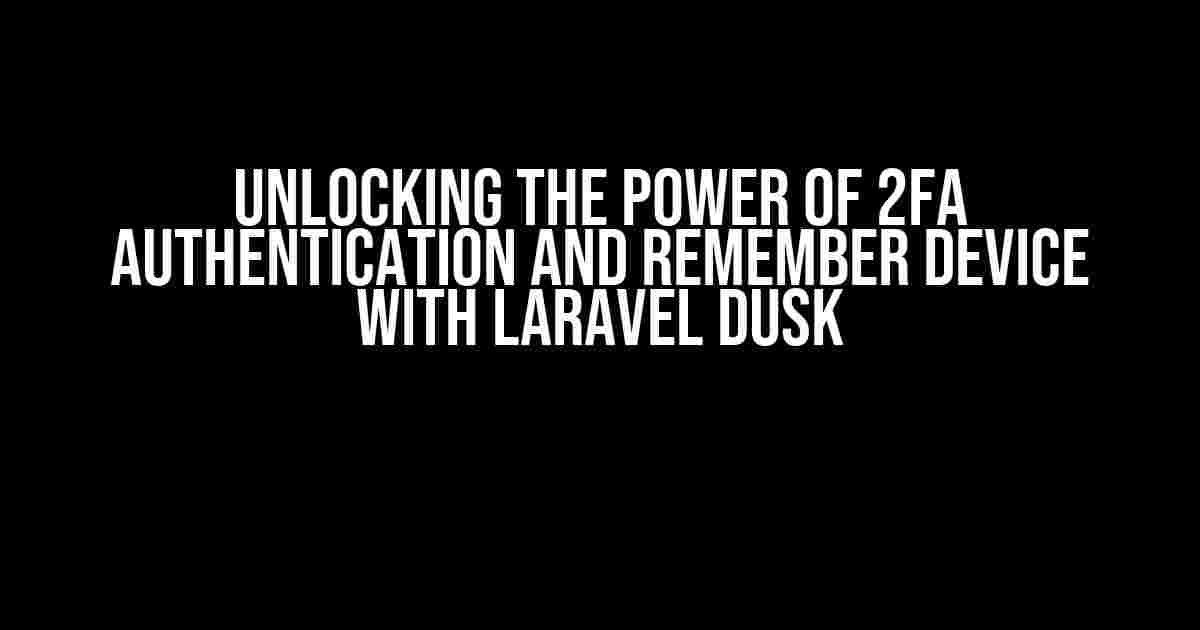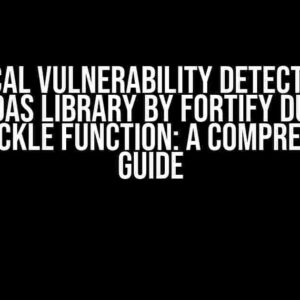Are you tired of compromising on security while still wanting to provide a seamless user experience? Look no further! In this article, we’ll delve into the world of 2FA authentication and remember device functionality using Laravel Dusk. By the end of this comprehensive guide, you’ll be equipped with the knowledge to safeguard your application while delighting your users.
What is 2FA Authentication?
Two-Factor Authentication (2FA) is a security process that requires a user to provide two different authentication factors to access an account or system. This adds an additional layer of security to the traditional username and password combination, making it more difficult for attackers to gain unauthorized access.
Types of 2FA Authentication
- Something You Know: This includes passwords, PINs, and other secret knowledge.Something You Have: This includes physical items like smartphones, tokens, and smart cards.
- Something You Are: This includes biometric data like fingerprints, facial recognition, and voice recognition.
Implementing 2FA Authentication with Laravel Dusk
Laravel Dusk is a popular PHP framework that provides an expressive, elegant syntax for building robust and maintainable applications. To implement 2FA authentication with Laravel Dusk, we’ll use the built-in `auth` middleware and the `AuthenticatesUsers` trait.
// In your User model
use Illuminate\Contracts\Auth\MustVerifyEmail;
use Illuminate\Foundation\Auth\User as Authenticatable;
class User extends Authenticatable implements MustVerifyEmail
{
// ...
}
// In your LoginController
use App\Http\Controllers\Controller;
use Illuminate\Foundation\Auth\AuthenticatesUsers;
class LoginController extends Controller
{
use AuthenticatesUsers;
// ...
}
Generating 2FA Codes
To generate 2FA codes, we’ll use the `google2fa` package by Google. Run the following command in your terminal:
composer require google2fa/google2fa-qrcode
Next, add the following code to your User model:
use Google2FA;
class User extends Authenticatable implements MustVerifyEmail
{
// ...
public function getTwoFactorAuthEnabled()
{
return $this->google2fa_secret !== null;
}
public function getGoogle2FASecretKey()
{
return $this->google2fa_secret;
}
public function generateGoogle2FASecretKey()
{
$secret = Google2FA::createSecretKey();
$this->google2fa_secret = $secret;
$this->save();
return $secret;
}
public function getGoogle2FAPassword()
{
$google2fa = new \Google2FA();
return $google2fa->getTotpCode($this->getGoogle2FASecretKey());
}
}
Displaying the 2FA QR Code
To display the 2FA QR code, add the following code to your login view:
@if (Auth::user()->getTwoFactorAuthEnabled())
@php
$google2faUrl = 'https://chart.apis.google.com/chart?chs=200x200&cht=qr&chl=' . urlencode(
Google2FA::getQRCodeGoogleUrl(
'Your Company Name',
Auth::user()->email,
Auth::user()->getGoogle2FASecretKey()
)
);
@endphp
 @endif
@endif
Remember Device Functionality
Remember device functionality allows users to trust their devices, eliminating the need for 2FA authentication on subsequent logins. To implement this feature, we’ll use Laravel’s built-in `session` middleware.
Storing the Remember Token
Add the following code to your User model:
class User extends Authenticatable implements MustVerifyEmail
{
// ...
public function setRememberToken($token)
{
$this->remember_token = $token;
$this->save();
}
public function getRememberToken()
{
return $this->remember_token;
}
}
Generating the Remember Token
In your login controller, add the following code:
use Illuminate\Support\Str;
class LoginController extends Controller
{
use AuthenticatesUsers;
// ...
protected function authenticated(Request $request, $user)
{
if ($request->has('remember')) {
$user->setRememberToken(Str::random(60));
}
}
}
Verifying the Remember Token
In your middleware, add the following code:
use Closure;
class VerifyRememberToken
{
public function handle(Request $request, Closure $next)
{
$user = $request->user();
if ($user && $user->getRememberToken() === $request->cookie('remember_token')) {
// User has a valid remember token, bypass 2FA authentication
return $next($request);
}
// User does not have a valid remember token, prompt for 2FA authentication
return redirect()->route('2fa.login');
}
}
Conclusion
In this article, we’ve explored the world of 2FA authentication and remember device functionality using Laravel Dusk. By following these steps, you’ll be able to provide an additional layer of security to your application while still offering a seamless user experience.
| Advantages | Disadvantages |
|---|---|
| Enhanced security | Additional complexity |
| Improved user trust | Potential usability issues |
| Faster login experience for trusted devices | Requires additional infrastructure |
Remember, security is an ongoing process that requires continuous improvement. By staying ahead of the curve and implementing robust security measures, you’ll be able to protect your users and maintain their trust.
Get Started Today!
Now that you’ve learned the ins and outs of 2FA authentication and remember device functionality with Laravel Dusk, it’s time to put your newfound knowledge into practice. Start building a secure and user-friendly application today!
Frequently Asked Question
Get answers to your burning questions about 2FA authentication and remember device with Laravel Dusk!
What is 2FA authentication, and how does it work?
Two-Factor Authentication (2FA) is a security process that requires a user to provide two different authentication factors to access an account. In the context of Laravel, 2FA typically involves a password and a one-time password (OTP) sent to the user’s phone or generated by an authenticator app. When a user tries to log in, they must enter both the password and the OTP to complete the authentication process.
How does Laravel Dusk help with 2FA authentication?
Laravel Dusk provides a straightforward way to implement 2FA authentication in your Laravel application. It includes built-in support for 2FA using Google Authenticator, Authy, and other TOTP-compliant authenticators. With Dusk, you can easily generate QR codes, validate OTPs, and store 2FA secrets securely.
What is the “remember device” feature, and how does it relate to 2FA?
The “remember device” feature allows users to mark their devices as trusted, so they don’t need to enter the 2FA code every time they log in from that device. This feature provides a balance between security and convenience, as users can still benefit from 2FA protection while avoiding the hassle of entering a code every time they log in.
How does Laravel Dusk handle the “remember device” feature?
Laravel Dusk provides a built-in implementation of the “remember device” feature, which uses a cookie to store the device’s identifier. When a user marks a device as trusted, Dusk stores the device’s identifier in a cookie, allowing the user to bypass 2FA authentication for a specified period. This feature is easily customizable and can be tailored to fit your application’s specific needs.
Is it secure to implement 2FA with Laravel Dusk?
Absolutely! Laravel Dusk’s 2FA implementation is designed with security in mind. It uses industry-standard algorithms and best practices to store and validate 2FA secrets, ensuring that your users’ accounts are protected from unauthorized access. Additionally, Dusk’s code is regularly reviewed and updated to address any potential security vulnerabilities, giving you peace of mind when implementing 2FA in your application.


